Kreeft’s Case for the Divinity of Jesus – Part 3: The Argument for Premise (1A)
In Part 1 of this series, I showed that the main argument for the divinity of Jesus given by Peter Kreeft and Ronald Tacelli in Chapter 7 of their Handbook of Christian Apologetics goes like this:
1A. Jesus was either God, liar, lunatic, guru, or myth.
2A. Jesus could not possibly be a liar, lunatic, guru, or myth.
THEREFORE:
3A. Jesus is God.
In this post I will analyze and clarify the argument given by Kreeft and Tacelli in support of premise (1A).
FOUR DILEMMAS GIVEN TO SUPPORT PREMISE (1A)
The reasoning supporting premise (1A) is spelled out in a chart near the end of Chapter 7:
I. Jesus claimed divinity
…A. He meant it literally
……1. It is true___________________________________Lord
……2. It is false
………a. He knew it was false_______________________Liar
………b. He didn’t know it was false_________________Lunatic
…B. He meant it nonliterally, mystically______________Guru
II. Jesus never claimed divinity_____________________Myth
(HCA, p.171)
THE FIRST DILEMMA IN KREEFT’S CHART
At the highest level, Kreeft presents a dilemma between “Jesus claimed divinity” and “Jesus never claimed divinity”:
EITHER Jesus claimed divinity OR Jesus never claimed divinity.
The expression “claimed divinity”, however, is UNCLEAR, so this phrase needs to be revised:
EITHER Jesus claimed to be God OR Jesus never claimed to be God.
To make sure that this top-level dilemma is logically correct (i.e. constitutes a necessary truth, an analytic truth) and encompasses ALL logical possibilities, we should also revise it into the assertion of a disjunction of a specific claim and its negation (“P or not-P” is a tautology or analytic truth). The specific assertion that the highest-level dilemma is related to is this:
Jesus claimed to be God.
The top-level dilemma may be spelled out in plain English:
4. EITHER Jesus claimed to be God OR it is not the case that Jesus claimed to be God.
Statement (4) is an analytic truth that covers ALL logical possibilities. The second disjunct in this statement is this claim:
It is not the case that Jesus claimed to be God.
According to Kreeft’s dilemmas chart, this second disjunct implies the “Myth” view, the view that the New Testament portrays Jesus as claiming to be God but that this is a FALSE or FICTIONAL representation of Jesus; Jesus never claimed to be God:
5. IF it is not the case that Jesus claimed to be God, THEN the MYTH VIEW is correct (i.e. the New Testament portrayal of Jesus as claiming to be God is fictional).
We can represent the first dilemma and this alleged implication by means of a decision tree diagram:
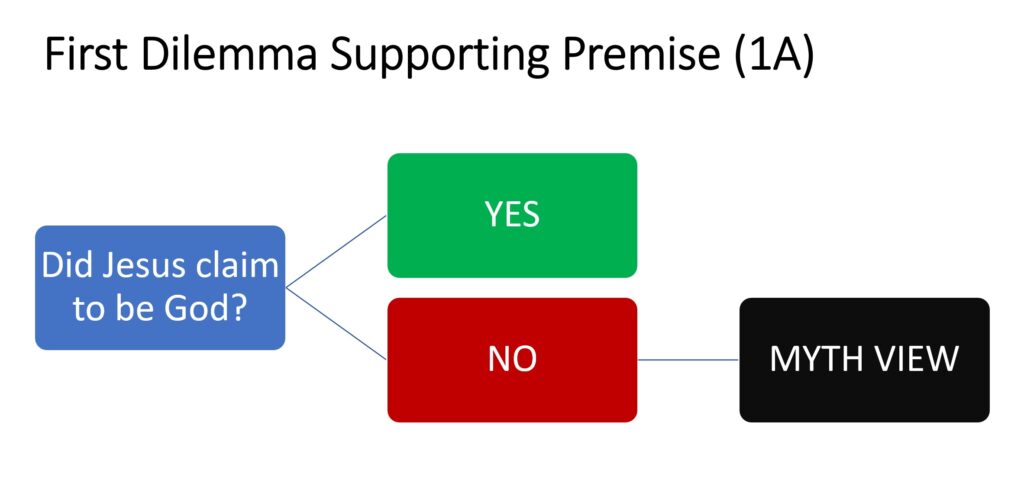
THE SECOND DILEMMA IN KREEFT’S CHART
Assuming that Jesus DID claim to be God, the next dilemma in Kreeft’s table (above) concerns whether Jesus meant this literally:
EITHER he meant it literally OR he meant it non-literally, mystically.
To make this disjunction clearer, we should eliminate the pronouns “he” and “it” and specify what those pronouns mean:
EITHER Jesus meant his claim to be God literally OR Jesus meant his claim to be God non-literally, mystically.
Kreeft has FAILED to make a logically comprehensive dilemma here by combining two different criteria (“non-literally” vs. “mystically”). Because these concepts have different meanings, Kreeft introduces confusion and ambiguity here. We should drop the reference to “mystically” and keep the reference to “non-literally” (or, better: not literally), because Kreeft needs the first disjunct to assert that Jesus meant the claim to be God literally, in order for the third dilemma to work. So, here is the clarified and logically corrected version of Kreeft’s second dilemma:
6. EITHER Jesus meant his claim to be God literally OR Jesus did not mean his claim to be God literally.
Note that both disjuncts ASSUME that Jesus claimed to be God, so this dilemma does not encompass ALL logical possibilities, but that is OK, because this dilemma occurs after the first dilemma, where one has to decide whether Jesus claimed to be God or not. The second dilemma only applies after one has determined that Jesus DID claim to be God, so the second dilemma covers ALL logical possibilities that exist assuming that Jesus claimed to be God.
According to Kreeft’s table of dilemmas, if Jesus claimed to be God and Jesus did not mean this literally, then the GURU VIEW is correct (i.e. Jesus held the mystical view that he was divine only in the same way that all humans are divine, and he was NOT claiming to be divine in the literal sense of being the eternal creator of the universe and the omnipotent and omniscient and perfectly good ruler of the universe):
7. IF Jesus claimed to be God and Jesus did not mean his claim to be God literally, THEN the GURU VIEW is correct (i.e. Jesus was only claiming to be divine in the sense that all humans are divine, and he was not claiming to be the eternal creator of the universe nor the omnipotent and omniscient and perfectly good ruler of the universe).
Here is the decision-tree diagram of the second dilemma from Kreeft’s chart:
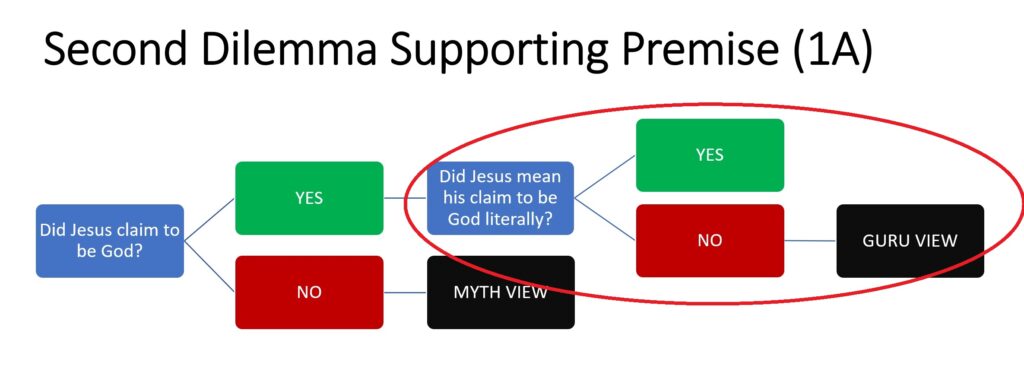
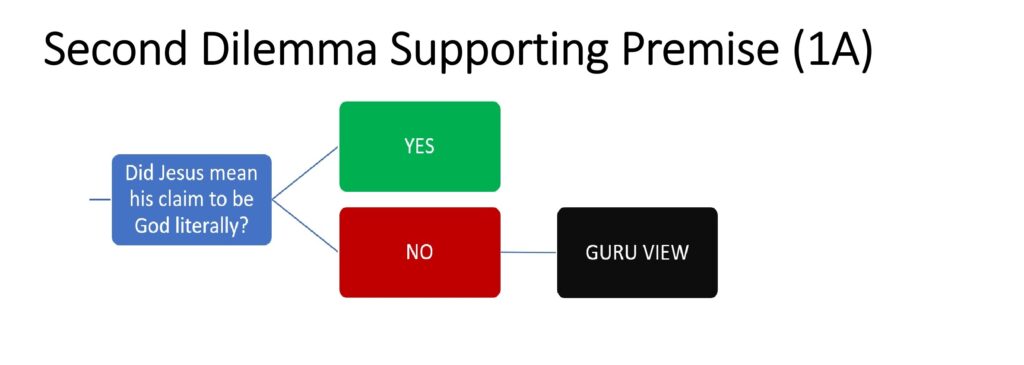
THE THIRD DILEMMA IN KREEFT’S CHART
Assuming that Jesus claimed to be God and that Jesus meant this claim literally, the next dilemma or choice is whether this claim is true or false:
EITHER it is true OR it is false.
For the sake of clarity, we need to eliminate the pronoun “it” and specify what this means:
EITHER Jesus’s claim to literally be God is true OR Jesus’s claim to literally be God is false.
This does not encompass ALL logical possibilities, because both disjuncts assume that Jesus claimed to be God and that he meant this claim literally. But that is OK, because this is the third dilemma, and the third dilemma only applies after we have already determined that Jesus claimed to be God (in first dilemma), and that Jesus meant this claim literally (in second dilemma).
However, Kreeft has FAILED yet again to encompass all of the logical possibilities that exist given the assumptions that Jesus claimed to be God and that Jesus meant this claim literally. Kreeft assumes here that any assertion that is not true must be false. But there is another possiblility: some assertions are neither true nor false, but are incoherent or nonsense. For example, the assertion below is nonsense:
The number sixteen sleeps furiously.
Although this sentence is grammatical, it makes no sense. A number is not the sort of thing that could sleep. And sleeping is not the sort of thing one can do furiously. So, this sentence is neither true nor false; it is simply nonsense. Some philosophers have argued that the following sentence is also nonsense:
God created the universe.
If those philosophers are correct that this sentence is nonsense, then this is another sentence that is neither true nor false. Furthermore, if those philosophers are correct, then a sentence that is directly relevant to Kreeft’s argument for the divinity of Jesus is also nonsense:
Jesus is God.
So, to avoid begging an important philosophical question, we need to reject Kreeft’s dilemma between Jesus’s claim being either true or false, and instead formulate the dilemma in terms of Jesus’s claim being either true or not true:
8. EITHER Jesus’s claim to literally be God is true OR Jesus’s claim to literally be God is not true.
According to Kreeft’s chart of these dilemmas, if Jesus claimed to be God and Jesus meant this claim literally and this claim was true, then the LORD VIEW would be correct (i.e. Jesus was God, and Jesus is God):
9. IF Jesus claimed to be God and Jesus meant his claim to be God literally and Jesus’s claim to be God was true, THEN the LORD VIEW is correct (i.e. Jesus is the eternal creator of the universe and the omniscient and omnipotent and perfectly good ruler of the universe).
Here is the clarified and corrected logic of Kreeft’s third dilemma represented in a decision-tree diagram:
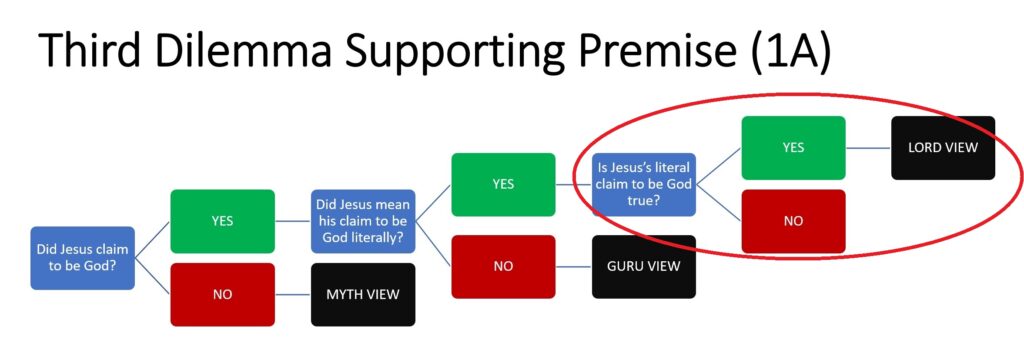
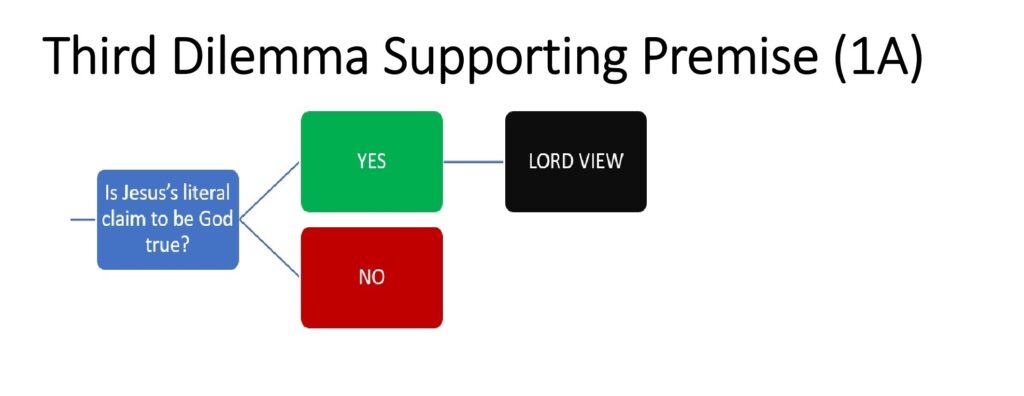
THE FOURTH DILEMMA IN KREEFT’S CHART
Assuming that Jesus claimed to be God and that he meant this claim literally and that this claim is not true, there are only two possibilities, according to Kreeft’s chart:
EITHER he knew it was false OR he didn’t know it was false.
Recall, however, that the clarified and corrected second dilemma does not talk about Jesus making a false claim, but rather, it talks about Jesus making either a true claim or a claim that is not true. So, Kreeft’s third dilemma cannot jump to the idea that Jesus’ claim was false. Here is a logically correct version of Kreeft’s fourth dilemma:
EITHER he knew it was not true OR he didn’t know it was not true.
For the sake of clarity, we need to eliminate the pronouns “he” and “it” and replace them with what they mean in this context:
10. EITHER Jesus’s claim to literally be God was not true and Jesus knew that his claim to literally be God was not true OR Jesus’s claim to literally be God was not true and Jesus did not know that his claim to literally be God was not true.
According to Kreeft’s chart of the four dilemmas, each alternative of this fourth dilemma implies a different view:
11. IF Jesus’s claim to literally be God was not true and Jesus knew that his claim to literally be God was not true, THEN the LIAR VIEW is correct (i.e. Jesus was a liar).
12. IF Jesus’s claim to literally be God was not true and Jesus did not know that his claim to literally be God was not true, THEN the LUNATIC VIEW is correct (i.e. Jesus was insane; Jesus was seriously mentally ill).
The clarified and logically corrected version of Kreeft’s fourth dilemma can be represented in a decision-tree diagram:


According to Kreeft’s chart, his four dilemmas encompass ALL logical possibilities, and lead to only FIVE views:
- The Myth View
- The Guru View
- The Lord View
- The Liar View
- The Lunatic View
If Kreeft’s four dilemmas FAIL to encompass ALL logical possibilities or lead to more than just the FIVE views that Kreeft specifies, then Kreeft’s four dilemmas FAIL to support premise (1A) of his main argument for the divinity of Jesus. In the next post of this series, I will evaluate Kreeft’s four dilemmas, based on the clarified and logically corrected version of them that I have presented in this current post, as represented by the decision-tree diagram that contains all four dilemmas (above).
